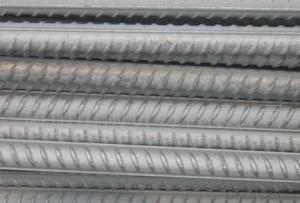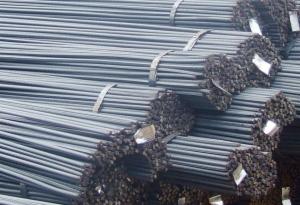Hot Rolled Steel Rebar For Concrete
- Loading Port:
- China Main Port
- Payment Terms:
- TT or LC
- Min Order Qty:
- -
- Supply Capability:
- -
OKorder Service Pledge
OKorder Financial Service
You Might Also Like
Product Description:
OKorder is offering Hot Rolled Steel Rebar For Concrete at great prices with worldwide shipping. Our supplier is a world-class manufacturer of steel, with our products utilized the world over. OKorder annually supplies products to African, South American and Asian markets. We provide quotations within 24 hours of receiving an inquiry and guarantee competitive prices.
Product Applications:
Hot Rolled Steel Rebar For Concrete are ideal for structural applications and are widely used in the construction of buildings and bridges, and the manufacturing, petrochemical, and transportation industries.
Product Advantages:
OKorder's Hot Rolled Steel Rebar For Concrete are durable, strong, and wide variety of sizes.
Main Product Features:
· Premium quality
· Prompt delivery & seaworthy packing (30 days after receiving deposit)
· Can be recycled and reused
· Mill test certification
· Professional Service
· Competitive pricing
Product Specifications:
Manufacture: Hot rolled
Grade: HRB335
Size: 6mm-25mm
Certificates: ISO, SGS, BV, CIQ
Length: 6m – 12m, as per customer request
Packaging: Export packing, nude packing, bundled
Grade | Technical data of the original chemical composition (%) | |||||||
C | Mn | Si | S | P | V | |||
HRB400 | ≤0.25 | ≤1.60 | ≤0.80 | ≤0.045 | ≤0.045 | 0.04-0.12 | ||
Physics capability | ||||||||
Yield Strength(N/cm2) | Tensile Strength(N/cm2) | Elongation (%) | ||||||
≥400 | ≥570 | ≥14 | ||||||
FAQ:
Q1: Why buy Materials & Equipment from OKorder.com?
A1: All products offered byOKorder.com are carefully selected from China's most reliable manufacturing enterprises. Through its ISO certifications, OKorder.com adheres to the highest standards and a commitment to supply chain safety and customer satisfaction.
Q2: How many tons of steel products could be loaded in containers?
A2: Usually the steel products are delivered by bulk vessel because of the large quantity and the freight. However, there are no bulk vessel enter some seaports so that we have to deliver the cargo by containers. The 6m steel product can be loaded in 20FT container, but the quantity is changed according to the size, usually from 18tons to 25tons.
Q3: what is the difference between actual weight and theoretical weight?
A3: All the section steel has two weights: actual weight and theoretical weight. Actual weight is the weighing out when the product delivered from the mill. Theoretical weight is calculated by pieces. The invoice can be based on each of them as your request.
.
Images:


- Q: Are steel rebars available in different shapes and profiles?
- Yes, steel rebars are available in various shapes and profiles to suit different construction needs.
- Q: What are the guidelines for storing steel rebars on a construction site?
- When it comes to storing steel rebars on a construction site, there are several guidelines that should be followed to ensure safety and maintain the quality of the rebars. Here are some key guidelines: 1. Location: Select a designated area on the construction site that is flat, clean, and well-drained for storing the rebars. Avoid areas prone to flooding or excessive moisture. 2. Elevation: Keep the rebars off the ground by using wooden or concrete blocks to prevent direct contact with soil or water. This helps prevent rusting and corrosion. 3. Stacking: Stack the rebars in a stable manner, ensuring that they are aligned vertically and horizontally to maintain their shape and prevent any bending or warping. Use spacers or crates between layers to maintain proper spacing and prevent entanglement. 4. Protection from elements: Cover the rebars with a waterproof tarp or plastic sheet to protect them from rain, snow, or excessive sunlight. This helps prevent rusting and degradation of the rebars. 5. Separation: Store different sizes and types of rebars separately to avoid mixing or confusion during construction. Clearly label and mark each stack to identify the type, size, and grade of the rebars. 6. Accessibility: Ensure easy access to the rebars for construction workers by organizing them in a logical manner. Place smaller rebars on top for easy retrieval and avoid storing heavy rebars on top of lighter ones to prevent damage. 7. Safety precautions: Maintain a safe distance between the rebars and any heavy machinery or equipment to minimize the risk of accidents. Secure the rebars properly to prevent them from falling or causing injury. 8. Regular inspection: Regularly inspect the rebars for any signs of damage, rust, or corrosion. Replace or repair any damaged or compromised rebars to avoid compromising the structural integrity of the construction project. By adhering to these guidelines, construction sites can ensure the proper storage of steel rebars, promoting safety, efficiency, and the longevity of the rebars.
- Q: What is the content ratio of the screw steel and manganese steel?
- Steel: content index mainly includes: C, Mn, P, S, Si, different grades, different content, its range is C (0.10 ~ 0.40%), Mn < 1.80%, P < 0.050%, S < 0.050%, Si (0.60 ~ 1%).
- Q: How do steel rebars resist fire?
- Steel rebars resist fire due to their high melting point and low thermal conductivity. Steel has a melting point of around 1370°C, which is higher than typical temperatures reached in building fires. This allows rebars to maintain their structural integrity even in high-temperature environments. Additionally, steel has a low thermal conductivity, meaning it does not readily transfer heat, minimizing the risk of fire spread and structural failure. The combination of these properties makes steel rebars a reliable choice for reinforcing concrete structures in fire-prone areas.
- Q: Are there any alternative materials to steel rebars for reinforcement?
- Yes, there are several alternative materials to steel rebars for reinforcement. One such material is fiber-reinforced polymer (FRP) rebars, which are made of high-strength fibers such as carbon, glass, or aramid embedded in a polymer matrix. FRP rebars offer several advantages over steel rebars, including high strength-to-weight ratio, corrosion resistance, and electromagnetic neutrality. They are particularly useful in applications where corrosion is a concern, such as marine environments or structures exposed to chemicals. Another alternative material is basalt rebars, which are made from basalt fiber reinforced with a polymer matrix. Basalt rebars offer similar advantages to FRP rebars, including high strength-to-weight ratio and corrosion resistance. They are also non-conductive and non-magnetic, making them suitable for applications where electromagnetic neutrality is important, such as in MRI facilities or near power lines. In addition to FRP and basalt rebars, other alternative materials for reinforcement include bamboo, timber, and composites made from natural fibers such as hemp or flax. These materials are often used in sustainable construction practices or in regions where they are more readily available than traditional steel rebars. While they may not possess the same strength properties as steel, they can still provide sufficient reinforcement for certain applications and offer other benefits such as low environmental impact or ease of handling and installation. Overall, the availability of alternative materials to steel rebars provides engineers and architects with a range of options to choose from based on the specific requirements of their projects, including factors such as strength, durability, cost, and sustainability.
- Q: Can steel rebars be welded to other steel components?
- Steel rebars have the capability to be welded to other steel components. In construction projects, welding serves as a common method for connecting steel rebars to various steel structures or components. This procedure involves heating the rebars and steel components to a high temperature, causing them to melt. Following this, they are allowed to cool and solidify, resulting in a strong and durable bond. Welding steel rebars to other steel components is widely accepted and contributes to the overall integrity and stability of the construction. By ensuring a dependable connection, it enables the rebars and steel components to effectively withstand external forces and loads. However, it is crucial to employ proper welding techniques and adhere to relevant industry standards and guidelines to guarantee a successful and safe welding process.
- Q: Are steel rebars suitable for reinforcement in schools and educational buildings?
- Yes, steel rebars are suitable for reinforcement in schools and educational buildings. Steel rebars provide excellent strength and durability, making them ideal for reinforcing concrete structures in high-traffic areas like schools. They help enhance the structural integrity and safety of these buildings, ensuring they can withstand heavy loads and potential seismic activity.
- Q: What are the standard sizes of steel rebars?
- The standard sizes of steel rebars typically range from 6mm to 50mm in diameter.
- Q: What is the role of steel rebars in the construction of foundations?
- Steel rebars play a crucial role in the construction of foundations as they provide reinforcement and strength to the concrete structures. By being embedded in the concrete, rebars enhance the tensile strength and durability of the foundation, helping it withstand heavy loads, prevent cracking, and resist deformation caused by ground movement or settling.
- Q: What is the impact of steel rebars on the overall sustainability of a structure?
- Steel rebars have a significant impact on the overall sustainability of a structure. By reinforcing concrete and improving its strength, steel rebars help to increase the lifespan of the structure, reducing the need for frequent repairs or replacements. This not only enhances the long-term durability of the building but also reduces the consumption of resources and energy required for construction. Additionally, steel rebars can be recycled, making them an environmentally friendly choice. Overall, the use of steel rebars in a structure enhances its sustainability by promoting longevity, reducing waste, and minimizing environmental impact.
Send your message to us
Hot Rolled Steel Rebar For Concrete
- Loading Port:
- China Main Port
- Payment Terms:
- TT or LC
- Min Order Qty:
- -
- Supply Capability:
- -
OKorder Service Pledge
OKorder Financial Service
Similar products
Hot products
Hot Searches
Related keywords




























